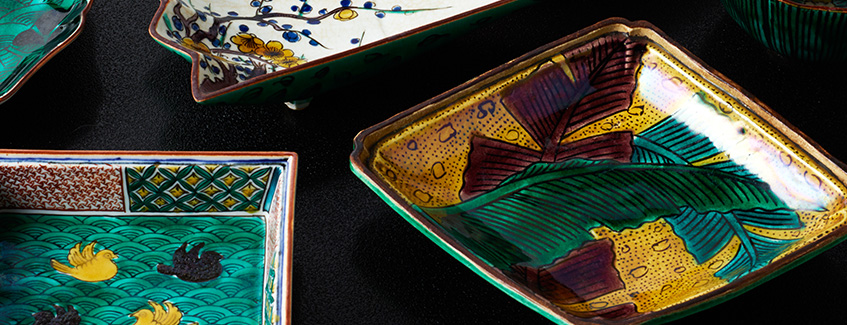Tableware

"Tai no Kara-mushi" - steamed sea bream, are usually served in Kutani Ceramic plates, while lacquered bowls are usually used for dishes such as Jibuni. Gorgeous artisanal plates and bowls are often used to serve the local dishes on.
Beautiful tableware to emphasis the colorful local dishes
There are many artisans creating tableware in the Ishikawa Prefecture. Kutani Ceramics, Wajima Lacquerware, Yamanaka Lacquerware, just to name a few. Many artisanal dishes and bowls are sold at reasonable prices. The locals take good care of the tableware they purchase. There are a lot of shops that repair broken tableware by filling the cracks or gluing pieces together with gold powder and lacquer for the people who want to keep on cherishing and enjoying their favorite tableware.
The higher quality restaurants in Kanazawa serve their dishes on high quality or sometimes rare or antique tableware.
Tea ceremony and Tableware
The 3rd lord of the region, Maeda Toshitsune, invested in culture instead of military power in order to alleviate the wariness of the central government. The Maeda clan nurtured a good relationship with masters of the tea ceremony. One of these tea ceremony masters was Kobori Ensyu. The Maeda clan employed many high skilled artisans to educate the local population. One of the reactions was the establishment of the Ohi-yaki Ceramics school. Even today, many masterpieces of crafts are being produced in Kanazawa.
The dishes served at tea ceremonies are called "Kaiseki": one bowl of soup, one boiled dish, one grilled dish and one plate of sashimi. The Kaiseki custom was established in the feudal era.
The dished served at tea ceremonies are carefully selected. The presentation aspect is very important. Many museums, such as the Kanazawa Nakamura Memorial Museum, have representations of the Kaiseki dishes and the indispensable tools that tea masters used on display.
links to relevant organizations
Kanazawa Traditional Arts & Crafts(English)
